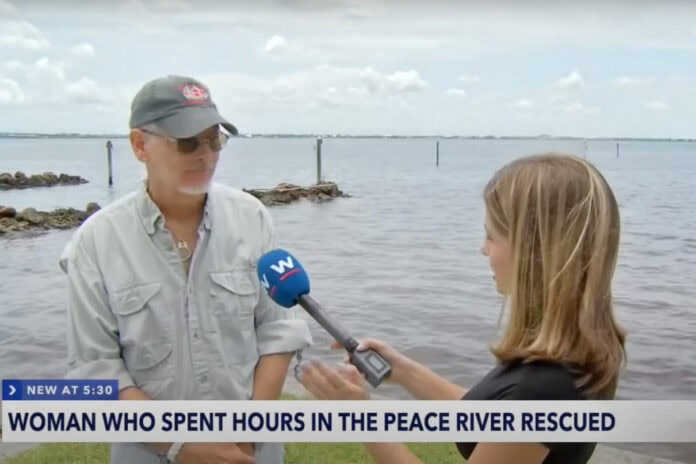A Florida woman was rescued in Charlotte County after her canoe capsized around nine in the evening and she was left to tread water overnight.
The canoeist was found the next morning by a good Samaritan charter captain, Russel Tryder, in the Peace River in the middle of Charlotte Harbor around ten in the morning. She was located about one mile from shore.
Charter captain rescues canoeist who spent night treading water
“I heard someone yelling ‘help’,” Tryder said in an interview with WINK News. “And I looked over and here’s a woman yelling ‘help’ and she was able to wave her hands.”
Tryder saw the woman’s head in the water and heard her calling for help, then turned his boat around to assist. As he approached, he saw the canoeist’s arms go up and her head go underwater. The canoeist told Tryder that she didn’t know how much longer she could hold on, and that she had been out all night.
Tryder was able to get a line to the canoeist and pull her aboard the boat. The canoeist was then able to climb aboard without assistance, WINK News reported.
“She kind of crawled on, and she was shivering and it looked like she was in the water for a long time,” Tryder said in the interview.
It was also reported that the rescued canoeist was one of two people in the canoe when it capsized; both paddlers were separately rescued by good Samaritans.
Surviving a capsize
Tryder told WINK News that the incident cemented for him the importance of wearing a personal flotation device (PFD), or life-jacket, when out on the water.
While many paddlers secure a PFD to their boat, PFDs and life jackets are nearly impossible to put on from the water, particularly in the conditions that cause capsize. Capsized paddlers may become separated from their paddle craft in the event of unexpected capsize; if the PFD is secured to the paddlers boat rather than worn, it can easily become lost when you need it most.
In addition to wearing a PFD, there are several other steps paddlers can take to decrease time in the water and increase chances of rescue. Leaving a float plan that details where you plan to paddle and when you plan to return with a trusted friend or family member is a great way to help rescuers know when to initiate a search, and where to begin searching. If attempts at self-rescue fail or are impossible, your next chance is to call for help. Beyond the float plan and a worn PFD, carrying several waterproof ways to call for help such as a cell phone in a secured dry bag, a VHF radio, a whistle, flares and/or a signalling mirror.
Rescuer Russel Tryder interviewed after saving woman who, after her canoe capsized, treaded water for 12 hours. Feature Image: WINK News | YouTube




The last six miles of the vaunted Texas Water Safari are across San Antonio Bay on the Gulf of Mexico. ALL boats are required by rule to carry three aerial flares with current expiration dates in the event they need help during the open water crossing. It is insane to be on open water without a way to signal the need for help in an emergency. A Garmin InReach would also be a smart thing to carry. And how did two paddlers in the same boat get separated from each other? I guess they were lucky the sharks weren’t hungry.